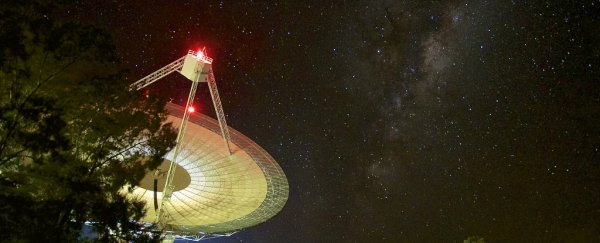Three more of the mysterious fast radio burst (FRB) signals have been detected this month, and one of them is a real record-breaker, coming in with the highest signal-to-noise ratio ever recorded. That makes it the "brightest" FRB that's ever been observed.
The signals came in on March 1, March 9 (that's the really bright one) and March 11, snagged by the Parkes Observatory radio telescope in remote Australia.
They are called FRB 180301, FRB 180309 and FRB 180311, following the fast radio burst convention of being named for the dates on which they occurred.
Fast radio bursts have become one of the most fascinating mysteries in space. They've only been detected from 33 sources in total, and only in the last few decades. One of those sources, FRB 121102, is unique in that it repeats. But most FRB sources only flash once, and then they're gone.
Each flash, a powerful radio signal generating as much energy as hundreds of millions of Suns, lasts just milliseconds, with no warning. They are therefore impossible to predict and, because the majority of them don't repeat, impossible to trace to a source.
FRB 121102 is the exception, and may help narrow down a phenomenon that causes fast radio bursts, but there are many theories - and it's entirely possible that there is more than one explanation.
The most recent research into FRB 121102 suggests its source is a neutron star, but other hypotheses include black holes, pulsars with companion stars, imploding pulsars, a type of star called a blitzar, a connection with gamma-ray bursts (which we now know can be caused by colliding neutron stars), and magnetars emitting giant flares.
It's not impossible that they could be engines firing on giant alien spaceships, either, according to a Harvard physicist. However, because they cover a spread of frequencies, they seem to be coming from very far away - possibly billions of light-years. This suggests that whatever is causing them has to be extremely energetic.
As with most other fast radio burst sources, the three from March - including FRB 180309, which has a signal-to-noise ratio four times higher than the previous brightest FRB - are not likely to be repeaters.
However, recording three fast radio bursts in one month is a pretty magnificent haul, considering how few have been detected to date.
Some researchers believe that most FRBs are actually repeaters, it's just that most of the signals they emit are too faint for us to detect.
An upcoming radio telescope project could help figure that out. The Australian Square Kilometre Array Pathfinder, which detected three fast radio bursts last year after it was switched on for the first time, is the pathfinder for the powerful Square Kilometre Array, being built across Australia, New Zealand and South Africa.
The SKA will include a low-frequency aperture array which may be able to capture those lower-frequency signals - if they exist. But the telescope will also cover a much wider area of the sky, in much greater detail, which means that fast radio burst discoveries may occur much more often.
Even if they are untraceable, that statistical data could potentially help tell us more about them. At the very least, we could learn how frequently FRBs are occurring.
So watch this space.
